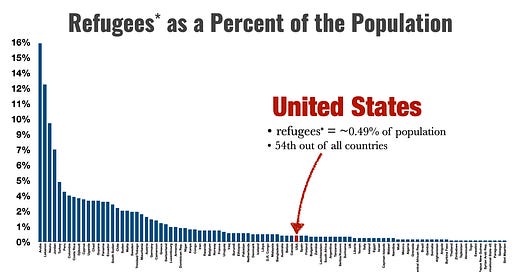One of the most common misconceptions about the global refugee system is that the United States represents an exceptional city on a hill, graciously opening its borders to the world’s dispossessed.
True, the US does typically receive a large number of refugees, asylum seekers, and other displaced people each year, and many people generously spend their lives and their careers trying to make the US a welcoming place for refugees who are seeking stability.
In reality, however, refugees actually make up a remarkably small percent of the total (large) US population, especially when you consider how sensationalized and politicized refugees have become.
According to the latest refugee data from the UN and population data from the World Bank, the percentage of refugees, asylum seekers, and displaced Venezuelans combined make up less than half a percent (0.49%) of the total US population.
Out of a dataset of 167 countries with data, 97 countries have refugee populations over 0.1% (or 1 per 1,000). The United States ranks 54th in this list, somewhat ahead of the UK (0.4%) and Italy (0.3%) but behind Lebanon (12.6%), Turkey (4.8%), and Greece (1.5%).
To be clear: small percentages and changes in small percentages can have political and social consequences. A percentage is just one part of the whole story. But as these data and this graph emphasize, it is important to put the US in a global context and to put the data on refugees in perspective.
Support public scholarship.
Thank you for reading. If you would like to support public scholarship and receive this newsletter in your inbox, click below to subscribe for free. And if you find this information useful, consider sharing it online or with friends and colleagues.





Great work! Thanks Austin